|
FAQs about Astrea, Turbo, Collonista Snails,
Family Turbinidae
Related Articles: Gastropods, Sea Slugs, Mollusks, Abalone,
Related FAQs: Marine Snails 1, Marine Snails 2, Marine Snails 3, Marine Snails 4, Snail ID 1, Snail ID 2, Snail Behavior, Snail Selection, Snail Compatibility, Snail Systems, Snail Feeding, Snail Disease, Snail Reproduction, Mollusks, Sea Slugs, Abalone,
|
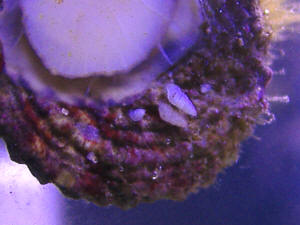
|
High Magnesium and Turbo Snails 2/4/13
Hello crew, hope you are well. I've written several times before about
my inability to keep Turbo Snails alive in my hair-algae-infested 29
gallon FOWLR tank. I'm still having the problem. My magnesium reads at
1500 ppm or slightly above with my Salifert kit. I've seen statements
that magnesium is a muscle relaxant for snails.
<Yes... for most all animals>
They die within a week or so, and do seem to fall down a lot before they
succumb. I've tried Instant Ocean and Tropic Marin salts lately, and the
newly-mixed saltwater always tests at 1500 or above.
<Strange. You want it, [Mg], to be about three times the concentration
of Calcium>
I went to a good fish store today, and they confirmed the 1500 magnesium
reading. They said this was surprising, since salt mixes generally
produces less magnesium than this (especially Instant Ocean).
<Agreed>
They suggested the extra magnesium may be coming from my water source
(RO, but not DI).
<Mmm, nah>
I tried to test for magnesium in my RO water, but the Salifert Mg test
kit doesn't seem to work with fresh water. So my questions: is this
magnesium level (with a calcium level generally between 400 and 450)
capable of killing turbo snails in a couple of weeks?
<Yes; it can>
(Other inverts, such as Margarita Snails and Fire Shrimp, seem to do OK
in the tank.) Is it likely for 100 to 200 ppm of magnesium to pass
through my RO filter?
<Not>
Is there a way I can test for it (i.e. a test that works in fresh water)?
<There are... you might look on Hach and LaMotte's websites... or a lab
nearby or distal that you can send a sample to for testing>
I don't want to buy a DI filter without a good reason. Thanks, Jerry
<Welcome. Please do report back to us w/ your further findings. Bob
Fenner>
Re: Turbo Snails Dying 1/5/13
Bob, As always, thanks for your prompt and helpful comments. I put ten Turbos in
the tank last time (I know that's too many for permanent residence), so it's
hard to believe the fire shrimp is attacking all of them.
<Mmm, have seen this before>
Actually, the shrimp hides except for when I put in food, so unless he turns
into a maniac at night, I think he's exonerated. Interesting about the toxic
algae. But I have a Tail Spot Blenny that frequently chomps on the fuzzy algae,
and the margarita snails presumably do too. So hopefully it's not a toxicity
problem. I'll calibrate my refractometer to make sure my SG values are correct.
To make sure I understand...are you saying that Turbos shouldn't be exposed to a
SG change of more than 0.001 per day?
<Yes; a good general rule>
So that, for example, if my display tank is at 1.025 and the store water
is 1.028, I should not try to acclimate them to the display tank, but should
rather put them in a quarantine tank at close to 1.028, and transition them to
the display tank conditions over a time not less than 3 days?
<Correct>
Thanks, Jerry
<Welcome. BobF>
|
Help in Invert ID
– 11/20/12
Hello Awesome WWM Crew!
Can you please help me identify this hitchhiker in my tank, and is it safe
to keep in a reef tank? Kinda like its appearance and I'm thinking of
keeping it :)
Thanks!
Gabe M
Can't make out what this is from your blurry pix Gabe. Can you provide some
that are better resolved? Have sent along to LynnZ for her go. Bob Fenner
|
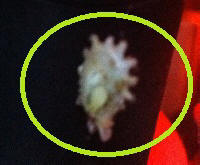
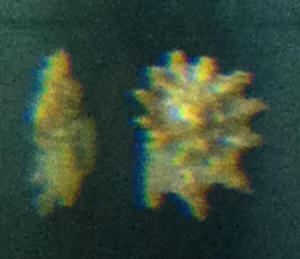 |
|
Re: Help in Invert ID
– 11/20/12
I'll try, the little bugger is a bit hard to find,
<Do send along a physical and behavioral description as well please>
just managed to snap this shot with my phone last night when it was in
broad *cough* daylight.
<A small digital camera is much better>
Will send a better one when I see it again.
Thanks, Bob.
<Welcome Gabe. B>
Re: Help in Invert ID
11/20/12
Thanks Bob, it looks like a Lithopoma/Astraea species of some sort.
I'll send Gabriel a reply (through WWM) ASAP!
Take care,
-Lynn
<Ahh, thank you Lynn. B>
Help in Invert ID – Turbinid and Possible Whelk – 11/20/12
Hello Awesome WWM Crew!
<Woohoo! Thanks, and hello to you too!>
Can you please help me identify this hitchhiker in my tank,
<It appears to be a harmless Turbinid (family Turbinidae) snail of some
sort. Could you tell me where it came from originally? Also, if you
could send along a more detailed photo (or two) and tell me the approximate
size that would be most helpful. Please see the following link for
examples of Turbinids (each photo is a link to more information and photos):
http://www.gastropods.com/Taxon_pages/TN_Family_TURBINIDAE.shtml#TURBINIDAEASTRAEINAE
>
…and is it safe to keep in a reef tank?
<If it is indeed a Turbinid, then yes, it’ll be fine. That is, it will
consume film algae, diatoms and the like, and will not pose a threat to any
corals or other livestock. All in all, it’ll be a terrific addition to
your clean-up crew. I’m actually more concerned about the snail seen
at the bottom of image 4111. It looks a lot like a whelk, a common
hitchhiker on live rock from Florida that preys on other snails and small
invert’s. Do send along a detailed photo or two and I’ll do my best to
confirm whether it could be a problem.>
Kinda like its appearance and I'm thinking of keeping it :)
<Yep, it’s a beauty alright!>
Thanks!
<You’re most welcome! Take care, Lynn Z>
Re: Help in Invert ID
11/21/12
Hey Bob,
<Big G!>
I think I know what snail it is, Lynn gave me an awesome link to help me ID
it.. from the looks of it, it's Bellastraea squamifera. Definitely a keeper
:D
Thanks, Bob
Gabe
<Cheers, BobF>
Re: Help in Invert ID – Turbinid and Possible Whelk – 11/21/12
Hello Lynn,
<Hello Gabe!>
Thank you for your reply and that really useful link.. definitely going to
my bookmarks :D
<You’re very welcome; I’m glad I was able to help.>
From there, I think it's Bellastraea squamifera, looks exactly like it, a
bit different on its shade but the resemblance is uncanny. It's about
a quarter of an inch across & flat when viewed on the sides. Awesome if it
is! :D
<Yes indeed! It’s definitely a pretty little snail, but time (and maybe a
bit more info) will tell regarding the ID. Complicating the issue is
the fact that your individual is most likely a juvenile and its shell may
significantly differ from than of an adult. We really need to find out
where the snail originated in order to have the best chance at a solid ID.
If it arrived on live rock, where was it from? At any rate, even
without that knowledge, I can tell you that your snail does not pose a
threat to other livestock so I say enjoy! For what it’s worth, here’s
another potential candidate (Astralium phoebium, aka the Long-spined Star
Snail):
http://www.gastropods.com/3/Shell_323.shtml >
I actually bought the snail at the bottom of the picture - four of them, LFS
said they're Nassarius. So far, they've been doing a good job at
eating detritus and left over food. Should I be concerned?
<Well, if it’s a true Nassarius, no. Just keep the snails well-fed,
since they’re mostly scavengers, and they should do just fine. The
trick is to find out whether they’re really Nassarius spp. snails or
something else entirely. Just out of curiosity, do your snails
look like the ones (Ilyanassa obsoleta, aka the Eastern Mud Snail) at the
following site?
http://z14.invisionfree.com/Conchologist_Forum/ar/t2240.htm?
If so, do use our Google search engine for more information and/or contact
me. Last but not least, please see the following link for more
information regarding Nassarius spp. snails, including how to recognize them
by a characteristic groove in their shell (start about half-way down the
page): http://web.archive.org/web/20010410073108/http://www.animalnetwork.com/fish/library/articleview2.asp?Section=&RecordNo=166
>
I'm planning to buy some more CUC inverts and I definitely don't want them
eating those O.O
<No, indeed!>
Thanks!
<You’re most welcome!>
Gabe M
<Take care, Lynn Z>
Re: Help in Invert ID – Turbinid and Possible Whelk – 11/22/12
Howdy Lynn,
<Howdy Gabe>
I'm afraid there's no way to really know where the rock came from.. But I'm
in the tropics so the Liverock would also be from the surrounding regions,
if that's any help at all.
<No worries, suffice it to say that it’s a beautiful little snail and
harmless to boot!>
For the other snail, it doesn't look like any of those Ilyanassa obsoleta
ones.
<Good, those are a cooler-water species that have been sold online and in
some of the LFS in the US as a Nassarius spp. (but they're not!), so I
thought I’d cover that base just to be sure. If you’re outside of the
US in the tropics, then chances are good that your LFS won’t be offering
those snails.>
Although, it doesn't look quite exactly like the Nassarius spp snail either.
I'll check later if they have that groove in their shells.
<Sounds good. Do let me/us know if you need any more assistance with
the ID.>
So far they have been laying eggs like crazy in the tank (same in appearance
with the Nassarius eggs when I searched).
<Gotcha>
And I read somewhere, and I don't know how true, that snails laying eggs are
indications that they are eating well?
<That’s what I’ve heard/read as well.>
I did notice a hitchhiking brittle star with missing legs though, and
another hitchhiking clam that mysteriously got emptied out.
<It happens. Hitchhikers can really get banged up and exposed to all
sorts of stresses during collection, transit, and curing. Regarding
the clam, sometimes they just don’t have enough food, especially in a new
tank, to sustain them so they die and the scavengers feast. >
They should not suppose to eat anything still alive right?
<Well, Nassarius spp., snails are scavengers that are attracted to dead
and/or damaged/dying tissue so healthy animals are safe while wounded
individuals may well be targeted (especially if there’s not enough available
food otherwise).>
I mean, I've seen them "walking" over the YW goby
<Do I ever love those comical little fishes!>
..and they literally smother him all over, tumbling the goby sideways,
turning him upside down.. in other words, really inappropriate ways :D .
The goby doesn't mind them at all, just lets them do as they please with
him.
<Heheeee! That is one tolerant little goby!>
If they ate the clam/star, I would think they would do the same with the
goby seeing that the fish isn't making any effort to escape their slimy
molestations :D
<Heeee, yes indeed! Any opportunistic predator worth its salt would
never turn down a meal that just sits there and allows itself to be mobbed!
Obviously the goby doesn’t perceive the snails as any sort of threat.
I would just keep an eye on the situation, keep the snails well-fed, and
only remove if/when necessary.>
Thanks,
<It was my pleasure, Gabe. Again, if there’s anything else we can do
for you, just let us know.>
Gabe M
<Take care, Lynn Z>
|
|
Parasite snails 8/15/12
I have some small snails hanging out on my turbo snails, I'm positive
they are a parasite of some sort.
<Yep, Pyramidellids.>
I only have two Turbos, both of them have 5-6 of these little snails
hanging out on them at all times.
<Likely many more. They retreat into the sandbed after they have had
there fill. The Pyramids are also feeding on your Collonistas, Limpets,
and other gastropod hitch-hikers.>>
I've had the Turbos themselves about 6 months, they have been surviving
just fine with the parasites. My concern is if they will eventually kill
the turbo?
<Pyramid snails reproduce rapidly; the damage inflicted will rise as the
population increases.>
It doesn't seem to be what would happen based off how well they are doing
over the last half year, but I suppose it could happen.
<It can.>
My other concern is I eventually want to have a T. squamosa or deresa, and
I've heard about little parasite snails on clams being a huge nuisance
and eventually fatal to the clam. If these snails can parasitize (that a
word?)
more than one species, then I'm worried.
<There are thousands of species of Pyramidellids. Some attack other
snails, some only eat clams, and some are not so picky moving from one
to the other.>
But if they are obligate turbo snail parasites, then I'm not so concerned.
<I would manually remove them as I see them. There are quite a few
wrasse that will eat them. Thalamita sima will prey on Pyramids but
finding a properly identified one for sale may prove difficult.
Thanks for all the help! You guys are great.
<Quite welcome.>
Grant
<Jordan>
|
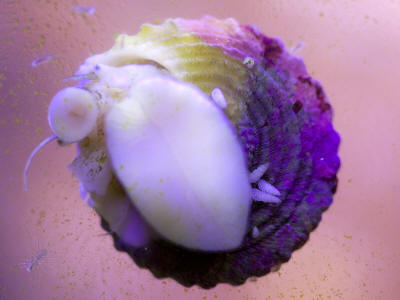 |
|
Re: Parasite snails 8/15/12 - 8/17/12
Thanks for the quick reply.
<Anytime.>
I always see these Pyramidellids hanging out on the shell of the turbo,
not actually on the flesh. How are they feeding?
<They have a long proboscis which is used to suck out fluids.>
Do they stick out a long tongue similar to a butterfly and feast off the
flesh or are they boring small holes through the shell and feeding in
that manner?
<Penetration is near the foot but the snail will be attached to the
shell.>
I was looking today from the moment the lights turned on until now, which
has been about 4 hours, and I never saw a single snail on the actual
flesh/meat of the turbo. I assume they must be sticking out a long
tongue that is just too small for my eyes to see, or else when I'm
seeing them they aren't feeding but are just hanging around for a free
ride on their food source.
<Actually seeing one eat may be quite difficult, if not impossible. Try
watching after lights out with a red light.>
<Jordan>
|
Raccoon butterfly and
disappearing snails/Butterflyfish/Compatibility 12/5/11
Hi WWM,
<Hello Gail>
As an aquarist who still needs more experience, I think I've made a
mistake, and would appreciate your opinion.
I have a young Raccoon butterfly - he's about 2-1/2 inches at
most.
He eats with great enthusiasm and gets fed ~4 times a day. I always
feed a mixture of frozen foods, always containing Mysis, although he
seems happy to eat anything. He's also cleared out the few Aiptasia
that were beginning to appear in the tank.
<Good.>
We haven't seen much of any of our original snails for awhile -
seemed we only had 3 or 4 left out of 12 - so two weeks ago, I bought a
couple of Mexican Turbos. (We're trying to control a bit of an
algae problem).
Yesterday, I found one turbo dead - only recently, I think - he was
whole in his shell. I haven't seen the other one for a few days. My
question: is it likely that the raccoon is the culprit?
<Possibly. They have been known to go after snails.>
If so, is there anything I can do to avoid the problem, or should I
just give up on snails? (I'm not keen to give up the raccoon).
<If you are sure the Mexican Turbos you have are indeed the Mexican
Turban, they can right themselves. Other species of Turbo Snails
cannot, so this may be a possible cause of death other than the
Raccoon. Turbo Snails can easily starve to death if an ample supply of
food is not present.>
Thanks in advance for your opinion,
<You're welcome. James (Salty Dog)>
Best wishes,
Gail HL
Turbo Snails and Clove
Polyps/Snail Compatibility 7/10/11
Hi Bob and crew:
<Hello Edie>
Once again I'm stumped----I can't find an answer to my
question. Sorry to bother you about this:
<Is what we are here for.>
I have a 90 gal mainly FOWLR but with several green star polyps,
several mushroom types (I'm not looking up the scientific names; I
hope that is o.k. in this case),
<No problem. Common or scientific names are fine.>
clove polyps, 3 cleaner shrimp, 7 fishes, (all doing great) and about 5
snails, two of which are the large turbo ones. My concern is about
1-1/2" turbo snails and the clove polyps. I saw one on a group of
clove polyps yesterday and now about half the polyps are gone. Do they
eat polyps?!!!!
Or do you think he was just cleaning up some dead ones.
<Turbo Snails are not corallivores, likely eating algae on the polyp
encrusted rock causing the polyps to retract and/or dislodge from the
rock.>
The polyp looked just fine until then. The snails have been in the tank
for over a year with no problems until now.
I've had the inverts 4-6 months and am enjoying them immensely.
This particular polyp seems to have multiplied, but so far, all
offspring are very small.
I don't want to get rid of the snails if I don't have to. They
do a good job with algae and are interesting to watch. Thanks again for
your help,
<You're welcome. James (Salty Dog)>
Edie
|
Another Live Rock Hitchhiker ID 5/15/11
Dear Crew,
<Joe>
Thanks so much for your time! Just a quick ID today.
<Ok>
I noticed several of these organisms upon viewing my reef this
evening. The tank has been set up for several years and has seen
flatworms, bristle worms, and Aiptasia among other pests, all
which have been easily managed thanks to WWM!
I've never seen anything like these and they have seemed to
have just popped up.
Nothing new has been added to the tank in 7 or 8 months.
They seem to have a mucus foot, and tiny shell, and two clearly
identifiable antennae. They look like baby snails. The one on the
top is actually two that are in close proximity. I'm sorry
about the pic quality- these boogers are tiny, perhaps 1 mm or
less.
I've not read much about snail reproduction evolving beyond
the egg stage in home marine aquaria and therefore doubt
that's what these guys are.
Any ideas? Friend or foe?
<Are these actually moving? To me they look
like small Syconoid sponges.
Please see the Net, WWM re. Bob Fenner>
Thanks!!
Joe
|
|
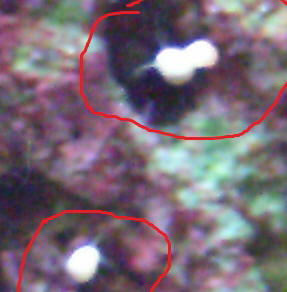
|
|
Re: Another Live Rock Hitchhiker ID
5/15/11
Thank you Bob!
<Welcome Joe>
I really appreciate your time! This is a busy month for you!
<Don't know what I'd do if I had a real job!>
These are definitely moving. The pic was taken
of the ones that are crawling on the aquarium glass. I did some
posting on our local forum and a couple of folks thought they
look like Collonista snails, which they indeed
do.
<Possible>
In any event, I doubt that they are any harm to the reef.
<As long as not too many in number...>
Thank you again, enjoy yourself, and as always, stay safe!
Joe
<Thank you. Cheers, BobF>
|
Turbo snail issue
4/18/11
Hi folks!
<Adam>
I've got sort of a dirty question for you: How do you stop an
amorous turbo snail from releasing massive quantities of what I can
only assume to be sperm?
<Hard to do... adverse conditions and propitious ones lead to this
behavior>
Here's why I ask:
I have a 20 gallon Nano and a 90 gallon reef. Once several months ago I
transplanted a turbo snail from my reef to my Nano to deal with an
algae issue. The next morning, I came downstairs and thought my tank
had crashed, the water was the colour of runny milk. After a brief
panic, I realized it was the turbo snail releasing a near continuous
jet of milky white fluid, with enough force to break the surface of the
water. I hadn't really wanted a turbo in a tank that small to begin
with, so I immediately returned it to the 90.
<Good>
Now, as I've reported to you guys in the past, I'm building a
new, much larger aquarium in the wall of my new house. Unfortunately
timing hasn't been my friend, and my current place has been sold
month and months ahead of our (very overdue) scheduled completion date
of the new house, so I've spent the last two days breaking down my
90. Thankfully I found someone on Canreef (AKA Reef Central North) who
was kind enough to set up a spare tank in his workshop to look after my
coral and fish for the next few months.
<Very nice>
Unfortunately, I missed one turbo snail in the move, and found it this
morning precariously drying out in the corner of the overflow of a now
empty tank. Since my friend lives over an hour away, I put the turbo
snail in my Nano. Lo and behold, 1 hour after it went in, it also
started ejecting massive volumes of white goo in to the water column.
It's not distressed as far as I can see, the thing is motoring
along eating, but every so often it stops and... gets happy.
<I'll say>
Does the extra protein in my water column from one snail have the
potential to crash the tank?
<Doubtful>
Is there anything in the tank specifically that might be triggering
it?
<Don't know... light period/icity, temperature most likely, but
there could be many other possible cues>
The tank has a skimmer now (it didn't the first time), so the water
hasn't gone completely opaque, but it's been in there for
nearly 5 hours and it keeps doing it! I've been reading online and
other than some hilariously familiar YouTube videos, I can't find
anything to indicate why it's doing it now.
<Again: "good or bad conditions">
I hypothesize that these snails pick up on the presence of sexual
fluids in the water to try to synchronize the timing of their spawning,
and that in my 20 gallon the small volume released from one snail leads
to a concentration high enough to induce even more of this behaviour
from that same snail, like a positive feedback loop gone crazy (I could
be totally wrong), but beyond adding a sump (which I can't do) with
carbon (which I have no space for) I don't know if there's
anything I can do to stop it.
<Nothing I'd do other than remove the snails... How to put
this... many/most marine organisms are to degrees feeders on gametes,
juvenile forms... Think on this>
Thanks again for your time,
Adam
<Welcome, Bob Fenner>
|
Collonista pic 1/21/11
Hi WWM crew...thought I'd share my first non-fuzzy pic of a
Collonista in my tank. He was nice enough to perch on an
outcropping of LR that is very close to the front glass. I
noticed him because he was 'blowing smoke' - sperm cloud
I presume. That's when I realized he was probably not a baby
Turbo, but a mature Collonista (he's about 1/4 inch
diameter).
Thanks for all your invaluable help and information!
-Tommy
<Thank you for sharing Tommy! Bob Fenner>
|
|
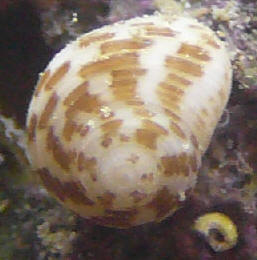
|
Lethargic Snails: Possible Lack
of Food - 5/13/10
Hey crew,
<Hello there Sam, Lynn here today.>
I have recently noticed that my Turbo snails have become lethargic (One
clings to a rock, moving an inch at most a day, while the other has
been retracted into its shell, motionless).
<Hmmm, that's not good. You might want to give the retracted,
motionless snail the "sniff test" to make sure it's not
already dead. Trust me, if it is, one sniff will prove it. If you have
tongs or gloves, this would be a good time to use them. The last thing
you want on your hands is dead snail juice - yikes! By the way, how
long have you had these snails? Do you know what species they are? Are
they the only snails you have? If not, how are the others
doing?>
My clownfish is still feeding, however spends most of its time swimming
into the glass in the bottom corner next to the 15-gallon rated heating
fixture.
<As long as the fish is still feeding and you don't see any
other outward signs of disease (white spots, etc.) then I wouldn't
worry too much. Clowns can exhibit some pretty strange behavior at
times but be perfectly healthy. I'd just keep an eye on it.>
My tank is a 14 gallon bio-cube, 78 degrees,
<That's on the low end, but okay.>
..with all parameters acceptable (zero nitrites, nitrates, ammonia,
etc.). I have not yet measured important trace elements such as
magnesium and phosphorous
<Phosphates? I take it that you're not adding anything (like
magnesium) without testing first, right? Too much magnesium can have a
negative effect on snails in that it works as a muscle relaxant. The
main symptom is usually the inability to hang onto the glass. If
you're adding it, definitely stop until you get the test kit. It
would also be a good idea to perform a water change.>
..as my order for those test kits is going real slow.
<It happens>
In the meanwhile, do you have any ideas as to what may be afflicting my
tank?
<Hmmm, well several things come to mind (if it's not the
magnesium issue). First of all, the snails may well be starving. Turbos
have huge appetites and two in a 14g is too much unless you really have
a runaway algae problem. Honestly, I wouldn't recommend one in a
tank that size, much less two. Fortunately, they'll accept dried
seaweed sheets (Nori) that you can get either at the grocery store (the
same sheets used for sushi), or at a local fish store. I would rubber
band some to a rock and place it near the Turbo that's still
clinging. I'd also pick up the other (confirmed alive) snail and
place it on, or next to, the seaweed covered rock and see what happens.
Hopefully they'll both respond and begin feeding. Beyond the
possibility of starvation, sometimes Turbos 'home' in on one
spot and stay there during the day after spending the night grazing
algae off the glass. It can appear that they're inactive when
actually they're just 'hanging out' waiting for darkness to
fall. What's troublesome though is the combination of an inactive
(but thankfully still clinging) snail and one that's just lying
there. That's not good.>
I have checked the archives and haven't seen anything about
"lethargic snails" and do not expect them to be old, as they
are under 2" and seemed to deteriorate at the same time.
<My guess is starvation. Do try the seaweed sheets. If the snails
respond, I'd make sure they were well fed then try to exchange both
for a single (much smaller) individual or something else entirely
(maybe Cerith snails or perhaps Trochus) at your local fish store.
Turbos are unparalleled when it comes to cleaning large swaths of
algae, but unfortunately, they can exhaust the available food supply in
a hurry and starve to death without supplemental feeding.>
Warmest regards,
<Take care>
Sam Sutton
<Lynn Zurik>
|
turbo snail HHs -- 03/24/10
Hello from Portugal! I hope you can identify what is in my turbo
snail.
The photo goes in attachment.
Best regards,
Pedro
<Mmm, can't quite make it/these out... Could be other
snails/Gastropods... might be discrete bits/colonies of a sponge
of some sort... there are even other possibilities. If
they're not apparently harming the Turbo, I'd
ignore/enjoy them. Bob Fenner>
|
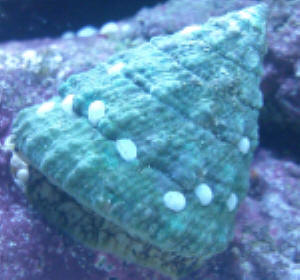
|
Re: turbo snail
3/24/10
Hi Bob,
> Those do look like gastropod eggs to me, too. Bogwood
in one of my tanks is covered with similar egg cases
produced by the various Nerite snails (see attached). For
some reason, the snails are picky, and only lay them on
wood, not plastic or glass.
> Cheers, Neale
<Thank you for this. BobF>
|
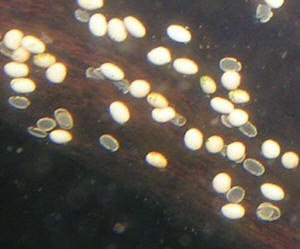 |
Re: More: re: turbo snail 3/24/10
Hi!!!
That's what I thought in the first place, but since I
only have got one Nerite I thought it was impossible for it
to mate.
Thank you for everything,
Pedro
<Perhaps you have more than one Nerite hidden somewhere?
Anyway, glad to have helped. Cheers, Neale.>
Comment on Re: More: re: turbo snail, Nerites
don't need "two to tango"
3/26/10
Good afternoon!
<Hello Audrey,>
Just a quick comment about the answer to the following
question Re: More: re: turbo snail 3/24/10 Nerites
don't need to mate to lay eggs. One lonely Nerite will
happily cover all suitable surfaces (wood, and occasionally
other snails' shells) with eggs.
<Very interesting. My specimens do seem to be mating
quite a lot of the time, but unlike the Clea helena or the
Tylomelania, I never find any baby Nerites. That's a
good thing or a bad thing, depending on your point of view,
I suppose. It does make them a great choice for tanks where
you don't want too many snails.>
They lay an incredible number of eggs each.
<Yes, they do!>
As usual, thank you so much for all your hard work,
Audrey
<Thanks for writing in! Cheers, Neale.>
|
|
hello. Turbo snail do-over
2/22/10
Hello crew! I just started searching the net for answers and found
your website..may I add that im a growing fan, and am outstanded by the
questions and answers that are given...thank u for helping out people
like me who have no clue what's going on...So here it goes...I recently
purchased a 10 gallon about 6 months ago...I started growing some green
algae so I decided to go to my local saltwater aquarium dealer and ask
which would be best...They handed me 4 Mexican Turbo's......now
they did a great job at devouring all my algae in the tank...but comes
to find out they knock a lot of stuff out of place and are quick
growers when eating a lot...But here's the main question...after they
cleaned my tank out outstandingly may I add....they seam to b heading
to my 50 dollar patch of green star polyps....if im wrong please
correct me..
<? Not likely to consume these>
its the polyps which wave in the water like grass...neon green and have
a purple "Paper" like base that u can rip off and frag and
have purple long tube like features when sucked in at night......now
this is a beautiful piece of artwork I have in the corner of my tank
and I would like to keep it there...any answers as to why my snails are
going after them?
<Lack of other food perhaps>
I had a pretty nice frag I moved to the left side of the tank which
they devoured overnight....
<Are you sure these are Turbinids?>
rubberbands and all! i couldn't believe it.....should I just take these
bad guys out?
<Looks like it>
Or do u have any other replacement algae eaters I can put in the
tank?
<... let me stop here. Your writing is not presentable... and you
haven't searched the site as requested before writing us. Let's
have you start over, here:
http://wetwebmedia.com/WWMAdminSubWebIndex/question_page.htm
Read, search, can the "Net speak", and we'll be helping
you help yourself.
Bob Fenner>
I see a lot of snails in the pet stores aquarium along wit the polyps I
have in my tank and they seem to b thriving awesome like feet upon feet
of that stuff in there tank....I just would like it to b happy and
stop getting eaten....thanks u for taking the time to read and reply to
my question....
Mike from Florida!
Snail Confusion: Astraea, Turbo
Classification Issues -- 2/3/10
Hi,
<Hello Rebekah, Lynn here today.>
I am interested in adding snails to my tank.
<Alright!>
I have a 55-gallon tank. It's been up and running for approximately
18 months and started out as a FOWLR but I'm slowly and steadily
making my way into inverts.
<Slow is good.>
Two peppermint shrimp (Lysmata wurdemanni) were the first invert
inhabitants and so far so good.
<Excellent>
So back to my snail question. I would like to get snails to eat algae
in my tank.
<You mean the green film algae that tends to build up on the tank
sides/walls, not a macro-algae, right? Or do you need the snails for
something else?>
I have been reading about many different snails. Lots of info I read
says that Turbo snails are excellent for algae but can knock things
around while bulldozing through your tank.
<The really big ones can occasionally, yes. They also have a big
appetite and can quickly go through the available food supply and
starve to death. The good news is that most will accept dried
seaweed/Nori sheets to supplement their diet. This can be offered via a
suction cup clip attached to the glass near the snail. You should be
able to find seaweed sheets either in the grocery store or at your
local fish store. Suitable clips, sometimes called "Veggie
clips" should be available at your local fish store as well, or
online.>
I don't think I want that, so I kept reading. Then I was reading
about Astraea snails.
<Love 'em.>
From what I read they are good with algae,
<Yes, they are.>
..stay smaller,
<Well, the common Astraea/Lithopoma tectum snails can get up to
about 2.5'. Six years ago I received an 1/8' juvenile, with a
live rock order, that's now pushing 2' top to bottom.
Thankfully, he doesn't seem to do any noticeable rearranging,
though.>
..but can't right themselves if they flip over. That sounds good,
I'll just keep a close eye on them in case they go bottoms up.
<Yes, as with all other livestock, it's always a good idea to do
a daily check.>
Then, here's where my confusion comes in...as I have been reading
more and more about these two snails, I have seen many references to
Astraea snails, Turbo snails, Astraea Turbo snails, and even Turbo
snails, genus - Astraea, species - tectum (or other). So is a Turbo
snail an Astraea snail (or the other way around)?
<Heee! Neither! Perhaps some of the confusion stems from the fact
that both are in the same Superfamily: Turbinoidea (aka
'turban' snails) and family: Turbinidae. It could be that
people are interchanging Turbinidae with Turbo. Beyond family level,
the two snails part ways into two subfamilies. The standard/commonly
offered Mexican Turbo snail (Turbo fluctuosus) is in the subfamily
Turbininae, while 'Astraea' (old name: Astraea tecta, now
Lithopoma tectum -- sometimes 'tecta') snails are in the
subfamily Astraeinae.>
I just want to make sure I know what I want and know the right
questions to ask at the LFS.
<Smart gal! If you have a lot of algae, you could try a small Turbo
and a couple of Astraea/Lithopomas and see how it goes. If you just
have a small amount, I'd skip the Turbo and go with a couple of
Lithopomas. Again, slow is good. You can always add more later on, if
desired. You'll still have to clean your tank sides regularly
though. If you bought enough snails to completely clean everything,
they'd soon starve to death, so don't fall victim to someone
telling you to buy at least 30 or 40 snails! As far as determining
which snail is which, look for general shape. Turbo fluctuosus has a
fuller, more rounded overall appearance while Lithopoma tectum has a
comparatively straight, more triangular profile. One thing I'd like
to mention, just in case, is that various species of Trochus snails
(Superfamily: Trochoidea, family Trochidae) are also commonly offered
in the trade (for algae consumption) and can be easily confused with L.
tectum. Some hobbyists swear by these snails, but I personally
haven't had much experience with them. The Trochus spp. we normally
see offered tend to have straighter, less knobby, sides than L. tectum.
Some also have an almost beaded surface texture and are beautifully
banded with color. If you're at all unsure, and specifically want
one variety of snail over the other, check the snail's operculum
(the trap door at the opening of the snail). Lithopoma snails have an
unmistakably thick, calcareous operculum (looks stony), while Trochus
snails have a thin proteinaceous/'horny' one that's
flexible and often amber to brown in color. Whichever snail you decide
to get, be sure to choose only those that are actively feeding or at
least up on the rocks/glass. Pass on any individuals just laying about
on the substrate. Please see the following links for examples of the
snails mentioned above. Just bear in mind that there can be variations
in color and degree of ornamentation within a given species. Otherwise,
the overall shape should be the same.
Turbo fluctuosus, the commonly offered Turbo snail (see whitish, thick
operculum): http://www.gastropods.com/3/Shell_2443.shtml
Lithopoma tectum, commonly offered as Astraea snails (thick, whitish
operculum): http://www.gastropods.com/0/Shell_1790.shtml
Trochus radiata, aka the banded Trochus (see thin amber operculum):
http://www.gastropods.com/9/Shell_2259.shtml >
I haven't been able to find a definitive answer. Too bad we
can't just all use the Latin names and avoid the nomenclature
confusion.
<It can be maddening, I know. Hopefully the above information will
help. Please let me know if there's anything else I/we can do for
you. If not, good luck with the new snails!>
Thank you for the clarification. Rebekah
<You're very welcome. Take care, LynnZ>
Re: Snail Confusion: Astraea,
Turbo Classification Issues -- 2/4/10
Thank you, Lynn.
<You're very welcome, Rebekah.>
To answer your question, I am interested in snails to eat the film
algae from the glass. So, your answer is perfect.
<Oh good.>
I feel like I'm back in Zoology 101!
<Me too, I'll save you a seat!>
Thanks!!
<You're welcome, enjoy those snails! Take care,
LynnZ>
|
Small Snail ID in Reef Tank: Collonista Snails --
1/8/10
Hello crew!
<Hello Jon, Lynn here this evening!>
I have a 125 gallon reef setup I've written in about before a
couple of times (thank you for the help on those once again).
<On behalf of Bob and the crew, you're very
welcome.>
I've noticed over the past 2 or 3 months a lot of small
(1/8" to 1/4") snails. I would say there are probably
200 of them in the tank, and that could be a low count. They are
mainly found on the live rock and the glass (the side and back
glass mostly,
<That's pretty typical for these snails.>
..which don't get cleaned as often as the front and probably
have more food on them).
<Exactly>
They are nocturnal, hidden during the day.
<Yep>
Their small size makes them difficult to photograph, but the
attached photos are my best attempt.
<Thanks>
Any ideas what type they might be?
<Yes, they appear to be a very common harmless/beneficial
snail in the genus Collonista, also known as 'Mini Turbo'
snails. These mostly nocturnal snails range in size from about
1/8' to 1/4' across and vary in color and pattern from
solid white to combinations of white with tan, brown, or even
pink markings. If you'd like to positively confirm the ID,
remove one of the snails and (using a magnifying glass) look for
a hole/pit in the center of the operculum (the 'trap
door' in the opening of the snail). For more information and
photos, please see the following links. Several FAQ's at the
first link re: http://www.wetwebmedia.com/snailidf14.htm
http://bb.wetwebmedia.com/viewtopic.php?f=25&t=242
>
They don't seem to cause any problems for the coral, other
inverts or fish,
<Nope, they're harmless herbivores.>
..but there sure are a lot of them.
<It happens. The population tends to wax and wane according to
the amount of available food. There have been occasional reports
of overpopulations leading to problems with equipment (getting
stuck within intakes and such) but I've had zillions of these
guys in my tanks for years with no problems. I can't say the
same for some other larger snails I've had! At any rate, if
you feel like you have too many, you can always opt for physical
removal. Perhaps you could give the surplus individuals to a
fellow hobbyist. They really are terrific little snails!>
I figure I probably am feeding something too much, helping their
population numbers.
<Not necessarily. They're more than likely just taking
advantage of those areas you can't reach with an algae
scraper and doing a little clean up for you. That's usually
where mine tend to congregate. As far as they're concerned,
it's the equivalent of a Las Vegas style all-night,
all-you-can-eat buffet and everyone's been comped!>
I could probably cut back on my feeding, but all of those things
dying in the tank doesn't sound all that great either...
<No kidding. As long as everything's doing well in the
tank and your water parameters are okay, I wouldn't change a
thing. Just think of the Collonistas as part of the nightly
cleaning crew!>
It's an interesting nightly event...
<Yes indeed!>
Thanks in advance,
<You're very welcome.>
Jon Hoover
<Take care, LynnZ>
|
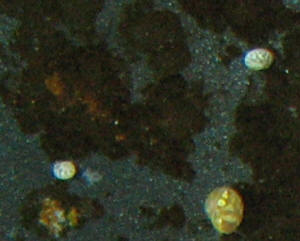
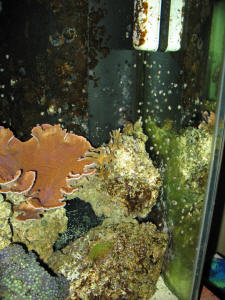
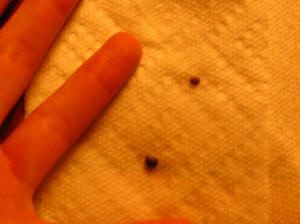 |
|
Snails: Likely Collonista Snails, Issues with
Disappearing Zoanthids -- 1/6/10
<Hello Tommy, Lynn here today.>
Help, I'm trying to ID this snail.
<Yay, I love snail ID's!>
I'm hoping it's not a Heliacus.
<I think you're in the clear. It looks like a common,
harmless, herbivorous hitchhiker in the genus Collonista,
sometimes called a 'Mini Turbo' snail. To positively
confirm, use a magnifying glass and take a good look at the
snail's operculum (the 'trap door' at the opening of
the snail). You should see a tiny pit/hole in the center. If you
don't see one, do try to get a few detailed photos and
we'll try again. Just for comparison, Heliacus spp. (aka
'Sundial') snails tend to be rather squat top to bottom,
with straighter sides, a rather heavy, almost 'beaded'
appearance to the surface, and an obvious cone-shaped operculum.
For more information/photos re: Collonista snails, please see the
related FAQ's at the following link:
http://www.wetwebmedia.com/snailidf14.htm
More here:
http://bb.wetwebmedia.com/viewtopic.php?f=25&t=242
Here's an example of Heliacus spp. snails:
http://www.gastropods.com/5/Shell_5765.shtml >
My zoo's are disappearing fast
<Uh-oh. If the water parameters/conditions and other livestock
are okay, then I'd look for either some sort of predator or
irritator, or evidence of disease. The list of potential
predators and irritators is long and includes Heliacus snails,
Pycnogonid spiders ('sea spiders'), Gammaridean
Amphipods, Vermetid Gastropods, Nudibranchs, a few crabs, various
fishes (Angels, Tangs etc.), tube dwelling Polychaetes, etc.(see
links below for photos). Your best chance of spotting some of the
smaller, and/or more cryptic individuals is at night with a
flashlight. If you're able to rule out pests, I'd look
into possible disease (pox, fungus, etc.). Take a good look at
the colony, especially the stems. Are there any light or whitish
spots present? Do the stems look fuzzy, spindly or unusually
dark? Once you determine what the problem is, please use our
Google search engine for a solution/treatment:
http://www.wetwebmedia.com/Googlesearch.htm
In the meantime, we have lots of information regarding Zoanthid
problems, starting here:
http://www.wetwebmedia.com/zoanthidhlthfaqs.htm
Check out this link for some terrific photos of Zoanthid
predators, irritators and pox:
http://zoaid.com/index.php?module=Gallery2&g2_itemId=384
>
..and I'm noticing that these snails are multiplying very
fast.
<Collonista snails can indeed multiply quickly, but don't
usually cause problems.>
These are the best pictures I could get.
<I think we're good to go with this snail. However, as per
above, if you find that what you have isn't a Collonista,
then do please let me know.>
Thanks for the help!
<You're very welcome!>
Tommy
<Take care, LynnZ>
|
 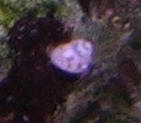 |
|
Critter ID? Operculums and Possible Sand Anemone -
3/19/09
<Hello Christopher, Lynn here this morning.>
A shell of a what?
<More like what's in the shell!>
One might think that after 40+ years of fishkeeping, 8 years of
outright reef obsession, and being supported by the bountiful
resources of WW, I could tell, or at least easily discover, if
something is a mollusk or a worm, or neither.
<Heheee! I've been in the hobby since the early 70's
and believe me, it happens.>
I recently had the opportunity to go bigger (50g to 125g).
<Nice>
After the 6 months of preparation, moving, acclimation,
quarantine, and additions to the new system, I finally have my
dream tank, short of glass walls everywhere. Thanks to advice
found on your site, I have had great success, the move went
swimmingly and the only surprises have been how much both my reef
inhabitants and I enjoy the larger space and there are these
shells. I have identified dozens of the hundreds of
'hitch-hiking' organisms that have populated my system
over the years and continue to pop up. While moving the old sand
bed as a 'start' for the new larger one I decided to sift
out some of the rubble that had accumulated from generations of
free limpets, tubeworms, Chitons, Nerites, Vermetid snails and
from the not-so-free snails, hermit crabs, coral base rocks and
the like. (A pair of maroon clowns can tend to break a lot of
things around their house over the years) Among the remains, I
discovered those of an animal that I had never seen before but it
had obviously thrived and multiplied for some time. They appear
to live or have lived on the glass bottom under the sand. What is
left are disk-shaped hard shells with a completely flat, almost
polished bottom and an intricate spiral growth pattern on the
top. I have attached a photo of the 'shell remains' that
I found in great numbers (dozens, perhaps hundreds) in the sand.
The three at the top are turned upside down to show the bottom
surface.
<They're snail operculums/opercula - the trap door at the
opening of a snail that protects the soft animal inside from
predation, desiccation, etc. Some are thin, and flexible, while
others are thick and calcareous. Yours are obviously of the
latter variety and most appear to be from bygone Turbo snails.
See these links for more information/comparison:
http://aphriza.wordpress.com/2006/12/21/trapdoor-on-the-seafloor/
http://seashellplace.com/catalog/images/others_eye_green.jpg
http://farm4.static.flickr.com/3261/2319171639_4443687a10.jpg
http://en.wikipedia.org/wiki/Operculum_(gastropod) >
I later remembered a photo I took a few years ago of some other
unidentified animals that I occasionally saw poking out from the
sand. After scouring your site at the time I assumed them to be
some sort of small anemone. I never could get a real up-close
observation of it and the only photo I got was this poor one
taken before I read all of your cautions about using a zoom lens
to take a close up in my aquarium. Perhaps it will be clear
enough for you to tell what kind of creature it is and whether it
is perhaps the maker of the shells?
<I sure wish I could help with this one, but I can't see
it well enough to be able to determine what it is. If I had to
guess, I'd say that it might be some kind of anemone,
possibly a sand anemone (Phyllactis spp). Please see the photo at
the following link for comparison:
http://www.flickr.com/photos/lemurdillo/3044460357/in/set-72157605663802360/ >
As you can tell it is about twice the size of a typical xenia
polyp. It had what appeared to be a plume of translucent fleshy
brownish speckled tentacles protruding from the 4-5' sand bed
next to the base rock. I am stumped by these guys and can't
seem to find images or descriptions of similar organisms.
FYI: 125 Gallon, 20 gal sump/refugium, deep sandbed, all
parameters are good.
Lots of healthy live rock with colorful algae, sponges,
tunicates, worms, tiny seastars, pods, macro algae, etc, etc. and
mature colonies of soft corals introduced years ago and
re-established over the rockwork.
Corals: Mushrooms, leathers, xenia and Zoanthids
A theme of relationships:
2 -- Maroon Clownfish (Premnas biaculeatus) mated pair (7 yr)
1 -- BTA (Entacmaea quadricolor) hosts above in separate
'bommie' (6 mo)
1 -- Pink Spotted Watchman Goby (Cryptocentrus leptocephalus) (4
yr)
1 -- Tiger Pistol Shrimp (Alpheus bellulus) (3 yrs)
5 -- Lyretail Anthias (Pseudanthias squamipinnis) (5 mo)
1 -- Blue Devil Damsel (Chrysiptera cyanea)
1 -- Midas Blenny (Ecsenius midas) (1 yr)
4 -- Canary Wrasse (Halichoeres chrysus) (1-5 yr, 3-4 mo)
2 -- Cleaner Shrimp (Lysmata amboinensis) (4 yr)
Grateful to have and to share it all. Any comments are
welcome.
Christopher Williams
Santa Barbara, CA
<Hope that helps! Take care, Lynn Zurik -- Everett, Wa>
|
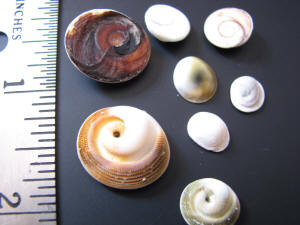 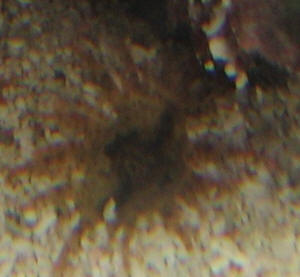 |
Strange Looking Astrea Snail
Shell 1/6/09
Good morning crew!
<And good morning to you, Jean.>
I'll cut to the chase, as I've written in before with all of my
tanks specs a week ago and things were commented on being ok, I know
this seems vague and won't help much in evaluating my problem, but
I was simply hoping for some small direction. I've been observing
one of my 3 Astrea snails shells' and I've noticed that the
bottom portion of his shell has turned an orange cream color, I was
wondering if this is indicative of new shell growth or is it possibly a
problem, maybe he's sick? Or one of my tank parameters is off, the
only thing worth noting is my nitrates have been abnormally high since
the start of my tank about 3 months ago and I've been diligently
trying to correct this in between frequent water changes to keep them
at least from raising any further. There are no predators in my tank,
and there are no visible signs of pests on him, all three of them have
normal behavior and feed quite well. I've taken a wonderful picture
of this, unfortunately I'm not able to attach this from the
computer I'm writing from. Any help would be much appreciated.
<I wouldn't worry too much about this, could be growth signs but
nothing to get alarmed about. As for your abnormally high nitrate
levels, read here and related articles/FAQ's.
http://www.wetwebmedia.com/nitratesmar.htm James (Salty Dog)>
Jan Dodes
Tiny Turbos (sys.) & mixed
clowns (comp.) 12/24/08
Hey y'all
<Hi Jessy here>
These are probably dumb questions.
<Nah. Perfectly valid>
First, I recently noticed tiny turbo snails in my sump and the column
off of my AquaC EV-120 skimmer. I'm assuming that's probably
the only place the larvae don't get picked off by my 75g tank's
other free-swimming inhabitants (scribbled Rabbitfish, 2 Banggai
cardinals, 2 clowns, 2 peppermint shrimp). I've pulled a few out
and deposited them onto the glass of my main tank. They are probably
2-3 mm across, but they do have shells. Will they fare better in the
main tank or are they better off left in the sump? It's not lit,
but I figure they're in the skimmer because they can feed on the
gunk that collects in the column.
I do clean it twice weekly, so that's why I noticed them there.
<These little guys would do great in the sump. Like you noticed
they'd most likely be picked off in the main tank, but in the sump
they will live happily on the tank sludge that inherently grows
there.>
Second, I recently introduced the clowns from 3 weeks in quarantine. I
bought a pair of Percula clowns initially; although they appeared
healthy and ate well, the larger one (about two inches) did not survive
more than a few days in quarantine. There were no visible signs of
disease, so I chalked the mortality up to shipping stress. After
testing the water, I bought a third and introduced it to quarantine.
Now I think the last one was a Ocellaris clown. They are slightly
different colors of orange, something I couldn't tell until they
were in the tank together. The Percula is a paler orange with prominent
black bands, no black edges to its dorsal fin, and orange irises. The
Ocellaris is a brighter orange with less black but its dorsal and
pectoral fins are larger with black edges, and its eyes are all black.
All of them were sold to me as tank-raised, but the store could only
guess if they were Perculas or Ocellaris. I could have them mixed up,
but I think they are different species. Anyway, both are doing fine now
and swim together as a pair. The Percula is the larger of the two. Is
there any problem with these 2 remaining a pair? I don't plan to
breed them and I'm assuming if they did none of the offspring would
survive the rest of my tank's inhabitants (there are also many
corals:
several Sinularia, Montipora, Plerogyra, and various Zoanthids and
Anthelias).
<No problem at all with them pairing up. If your Perc is the larger
of the two, most likely it will be the female. And if you ever DID have
the notion of breeding them, it wouldn't be in your tank anyway.
Clownfish breeding is a labor intensive task with dedicated systems
required.>
Thanks for your input and Merry Christmas!
<Welcome and Merry Christmas to you and yours as well. Jessy>
Ed
New baby Astrea
12/23/08
Good morning crew! Many thanks to all of you who have created this
site, as a newly budding addict of the reef community it has been an
invaluable tool in starting my very first SW tank.
<Ahh! Am glad we have been of service to your efforts>
A little (ok, a lot) background... 30 gallon deep tank running with
little mechanical filtration other than the sponge filter (could be the
culprit of the high nitrates, will investigate today) I left in the
trickle filter/turned unfinished fuge ( no lights yet, full of rock and
a return pump). Been running for about 2 months with 25 lbs. of
"live" aragonite sand (more like crushed coral in a bag, best
I could do in Michigan in the winter). Plenty of rock in display, using
only RO/DI for top offs and premixed RO/DI SW from my LFS (they use Red
Sea). Added 3 Astrea snails a little earlier than suggested in the
nitrification cycle, but they survived. About a 2 weeks ago I added 2
mated skunk cleaner shrimp who have both molted, I think one has twice
so far.
<Neat>
And, two mated ocellaris clowns. I added a cluster of Caulerpa to the
display (yes I can feel the stares of disdain) to help with the
nitrates which gets pruned once a week and fed to my dad's tang to
keep things under control. I've researched Caulerpa a lot and
understand the risk, but things have gone well so far, if I have any
trouble, I'll pull it all immediately and bleach it down the
tub.
<Good to find you have looked into, understand, have a
plan...>
With the clump, I was fortunate enough to obtain 3 brittle stars and an
entire colony of amphipods and other stuff I can't see.
<Great>
The tank seems very happy so far, things are growing and all levels are
good. Ammonia, Nitrite, phosphate are all 0 ppm. Nitrate is at 40
ppm.
<Mmm... do keep an eye on this>
SG is a constant 1.024 and the temp is 79 degrees no noticeable
deviation. Oh, lights are ok for now, looking to upgrade in the near
future. (2x 15W GE aqua rays) Ok, so, was showing off my tank the other
day and noticed a very small baby Astrea cleaning the glass, he's
about 2-3 mm in size and I can see his mouth slurping away at the
glass. I've read that Astreas don't reproduce with much success
in captivity, could you help me understand why that is
<Mmm, don't know>
and am I just very lucky or is he doomed?
<Mmm, might be lucky... might be other genera, species...>
I'm positive he was not a hitchhiker, the rock I used had to be
cured myself as it was once live about 3 months before it was placed in
dry bucket outside in the summer and the only thing I've added is
what I've described above and food.
<Could have easily been introduced on/with the Caulerpa...>
Thank you so much for reading my long explanation for such a short
question. Hoping to hear back soon! J
Jan Dodes
<Thank you for sharing. Bob Fenner>
| Snail that blows smoke???????????? Hello Saw something
strange while observing my 46G reef tank after lights out. One of
the Astrea snails perched itself atop a rock , got up on its
"hind legs", and proceeded to contract its body, then
release to expel a cloud of something?, looked like smoke. It
continue this "ritual" for 15-20 minutes, three
contractions, three expulsions, a rest then again. I have never
seen this behavior before, caught it on video and also got a
picture. Any thoughts as to what the heck is /was going on?
Included picture, hope it opens properly. Thanks for your time
Stephen Concord, Mass. <Nice pic... your snail is/was
reproducing. No worries... likely a tasty meal for many other
organisms in your system. Bob Fenner> |
|
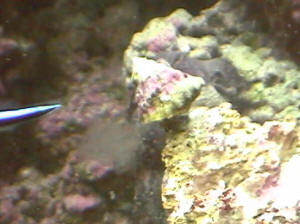
|
Turbo spp snails 12/23/07 Hi, I
have a 55 gallon salt water tank that I just recently replaced with a
new one. (the other on was over 15 years old and looking old). We also
moved to a new address so I thought it would be a good time to change
the tank. When I planned the move, I bottled reverse Osmosis water and
also bottled the actual water from the other tank. I did not add
anything new or different. I still had the same live rock, snails,
fish, substrate. I did and an undergravel filter which is in addition
to the top filter I was using. I moved them and they were only in a
bucket for about 2 hours. It has been about two weeks and all my fish
survived as well as the smaller Astrea spp. (I think) have all
survived, but within just 3-5 days I have 3 maybe 4 of my Turbo spp
snails are dying. I don't know what I did, I would have thought the
fish would show the first signs but they are fine. The snails are about
1 years old and I got them at the same time. Is that just their life
span or is something wrong? Thank you, Linda <Mmm, might be just
coincidence... if the Astrea survived... the Turbos should have also.
Bob Fenner>
Turbo snail diet = microalgae
12/28/06 Hello crew! <Hi Michael, Mich with you today.> I
just started with saltwater about 3 months ago, now it seems all my
time and money is devoted to it! <Yes, welcome to the obsession.>
Your website has proved to be an invaluable resource to my new hobby!
<A terrific tool, we hope you find it most useful.> My question
is, will turbo snails eat my coralline growth on my live rock? <No.
Urchins are known for this.> or do they mainly stick to the looser
material? <Turbos typically graze on microalgae, often on the glass
as well as the rock.> Thank you so much for all the help you've
provided me with!! <Welcome! Glad to hear this! -Mich>
-Michael
Algae Control/Snails 3/18/06 I
tried searching, and I am sure it is there somewhere, but there is so
much inform to retain. What type of snails control algae and also, how
many should I have in a 72 gallon tank? <Turbo and Astrea snails are
good choices. The amount needed is relevant to the size of the snails
and amount of algae you need to control. In your tank I would go with
five or six of each. <James (Salty Dog)> Thanks! <You're
welcome>
| Halichoeres melanurus and Pyramidellid snails
11/15/06 Hello crew, <Brandon> I have recently noticed
that there are many Pyramidellid looking snails attached to the
bottoms of my Astrea snails. <Sure looks like it> I've
been thinking of getting a clam once I decide on type and find one
I am content with but this is an obvious setback in the plan.
<Oh yes> I saw where a Halichoeres melanurus (Hoeven's
wrasse) was recommended to consume these pests but have looked at
some sites that say it is not a reef safe fish. <Is toward that
end of the scale... I'd say/state "largely
reef-safe"... how 'bout that?> What is your experience
with the fish in the reef setting? There's also a picture
attached that I took a few minutes ago. Thank you and have an
excellent day. Brandon <The smaller Halichoeres species
(there's a bunch!) are relatively peaceful, non-injurious to
cnidarians, other sessile invertebrates too small to be eaten
whole. Bob Fenner> |
|

|
Bristleworm biting Astrea snail
3/22/05 Hi there. Firstly thanks for all the information on your
site - I am just starting out and it has been of great use! <Glad to
hear.> I was wondering if you had ever come across bristleworms
biting snails? <<RMF has>> <Dead ones, yes. Live ones,
no. There is a type of worm that is bright red, long and thin that prey
on snails by smothering them in mucous before eating them.> I have
had my 50 gallon tank for about 3 months and have 20kg of live rock in
it. A couple of weeks ago I added three Astrea sp. snails to the tank
which were doing fine to begin with, sharing their home with three red
legged hermits and 2 common clownfish. However, over the past four days
I have lost two of the snails. The other seems ok - he is foraging
about the live rock for algae but this morning I saw this grey/beige
coloured worm with bristles down both sides emerge from the live rock
and start biting at the snails foot. It was only about 1-2mm wide - got
no idea how long as the rest is in the rock - I presume it is a
bristleworm. I saw the same thing before the other two snails died and
one had problems staying attached to the rock - it kept falling off. I
wondered if these worms could be the culprit - perhaps biting the feet
of the snails which is leading to adhesion problems or infection as
there seems to be nothing wrong with the water quality... Thanks for
your help and keep up the good work Sarah <It is possible, but
unlikely that the bristle worms are irritating or injuring the snails.
More likely, the worm was just "checking out" the snail. I
would consider the hermits to be much more likely culprits. Also,
snails are often mishandled and die early. I would consider the worms
innocent until proven guilty and keep a close eye on the hermits. Best
Regards. AdamC.>
Turbo snails harming my polyps?
7/5/05 Hi Crew, <Hi - Ted here> I wondered if you could
help me? I have a 30 Gallon tank, fully cycled, has been running for
about 10 weeks now. Vitals are as follows; SG - 1.022, Temp - 77,
Ammonia - 0, Nitrite - 0, Nitrate - 15ppm, pH - 8.1 Lighting is only 2
x 30 watt fluorescent tubes (1 x daylight plus - 1 x Actinic blue moon)
Inhabitants are; 1 x red legged hermit (about 3/4 inch in size) 2 x
unidentified "hitch hiker" crabs ( 1 tiny one and one about
an inch) 2 x Turbo snails Some Chaetomorpha. I have some Yellow
Parazoanthus polyps on a small piece of live rock positioned a few
inches beneath the surface because I know my lighting leaves a lot to
be desired. I am concerned for the polyps' health though. I
sometimes notice a turbo snail on the rock, it doesn't appear to be
eating them but it does look as though it could be harming them through
pure clumsiness (knocking them and pressing against them with its
shell) The same goes for the hermit crab too. Their health does seem to
have declined since I started adding other livestock (they were the
first live inhabitants). Some of them never open now and one of the
smaller ones has actually vanished, some of them sometimes look as
though they have been squeezed at the base as they go thinner (almost
as though they have had fishing line tied around the base and
tightened). I feed them weekly with a small amount of Mysis shrimp
(soaked in SeaChem reef plus) squirted on to them with a syringe which
they appear to eat in earnest. There is also an abundance of pods and
bristle worms in the tank. Do you know what may be causing the decline
of these polyps? I really like them and would love to keep them. (they
have been in the tank about one month) Sorry for the long message but I
wanted to cover as much as possible in one mail. Best regards and thank
you for whatever you can tell me. <Your water quality seems fine
although I'd like to see the nitrates lower. The presence of pods
and worms are an indication of good water quality. While polyps will
retract when disturbed, they should extend again so the snails are not
likely the problem unless they are constantly disturbing the polyps.
Your lighting may be contributing to the polyps decline. Keeping the
polyps near the light is a good thing but adding more light would be
better. You might also check the water flow in the tank. Chaotic water
flow will help the polyps. Finally, true crabs are opportunistic
predators. I would caution against keeping them in the tank as they may
view your other inhabitants as food.> Leif, Birmingham, UK. <Good
luck with your tank - Ted>
| Baby Snail Question. Hey, I'm not a baby,
I'm a Collonista! 3/30/08 Good day WWM, <Hi Josie!> I
am writing to get an opinion on a baby snail that I discovered in
my tank this morning. <It's actually not a baby/juvenile,
but rather a diminutive snail species usually referred to as a
Collonista, or Mini-Turbo snail. They're harmless and
beneficial herbivores/grazers that are mostly nocturnal, reproduce
readily, stay small (usually around 3mm), and have a characteristic
pit in their operculum (trap door at the opening of a snail).
Color/pattern varies, with some being all white like yours, while
others are combinations of white with varying amounts of mottled
tan/brown/even pink markings.> Currently, as far as snails go, I
only have Nassarius, Fighting Conch, and Margarita Snails and low
and behold, I find a small, ¼?white snail with 2
tentacles crawling on the glass this morning. I have done some
searching and found that Margarita Snails do not typically breed in
captivity; <Not successfully, no. In addition, they're
unfortunately cooler water species that live shortened lives in
reef systems.> ..however, the shape of this baby is nowhere near
the same as either the Fighting Conch or the Nassarius Snails.
<Very true.> I have not added anything new to my tank in
about 3 or 4 months and the tank is over 1.5 years old now.
<Because of their size and nocturnal nature, these little guys
are often overlooked.> The shape is very similar to the
Margarita. I have included a picture although it's not the
greatest as it's difficult to take good pictures of the tank
with the camera I have but it's the best I could do.
<That's okay, I think we're good to go! For more
information, please see the following links as well as WWM's
search engine using the term 'Collonista':
http://www.wetwebmedia.com/snailidf14.htm
http://reefkeeping.com/issues/2004-05/rs/index.php
http://www.wetwebmedia.com/WWMAdminSubWebIndex/question_page.htm
> Again, thank you so much for all the great information on WWM
as it's always my first stop for information! Josie <Mine
too! Bob and the crew past and present have amassed a very
impressive amount of information here, and it just keeps growing!
Take care and enjoy those Collonistas, -Lynn> |
|
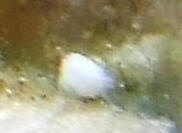
|
| Need an ID on a snail: Collonista sp. -
1/5/08 WWM crew, <Hi Nick.> Good evening. <And the
same to you!> I am trying to I.D. this snail. I cannot find
anything that looks like it any help would be appreciated. It is
about the size of a pea and is spherical. I only see them at night.
There are about 3 that I can tell. <Looks like you've got a
pretty little Collonista sp. snail there. They're terrific
little grazers - mostly nocturnal, and top out size-wise at about
1/4" (around 3mm or so is the norm). They vary in color
(brown/tan/white/even pink), and pattern, but all have a
distinctive pit in the center of the operculum. These snails do
reproduce in tanks, but rarely do the numbers get out of hand. One
thing I will mention is that there have been occasional reports of
them getting stuck/causing problems with equipment (intakes and
such). However, that same potential exists for just about any other
snail as well. I've never had a problem with these guys, but I
have with others. All in all, these are terrific little snails and
a great addition to a tank. Please see this link for more
information re:
http://www.reefkeeping.com/issues/2004-05/rs/index.php .> Thanks
in advance, <You're very welcome! Take care --Lynn> |
|
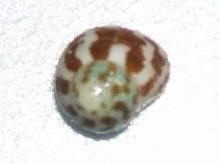
|
| What kinda snail is this? 01/13/2008
<<Hello, Andrew here>> I have hundreds of these little
guys in my quarantine tank. I started off with a couple and now
they have really taken off. They seem to be most active when the
lights are out. during the day most off them burrow into the
substrate. and when lights go out, they clean the glass. very
small, the biggest ones are about the size of a chocolate chip
thanks for all the help! <<They are Collonista SP snails.
They are just algae grazers and will cause no harm, you can always
remove start removing some if you experience plague proportions.
They stay very small too.>> <<Thanks for the question,
A Nixon>> |
|

|
Turbo snail eggs? Hey Gang, How y'all
doin'? <I'll spare you the details, but good and bad, such
is life> I think I just witnessed a large turbo snail make, or,
produce a large (thimble size) lump of eggs (?) looks like hundreds of
white, very tiny spheres everywhere in the current, as the floating
lump broke up. I suspect the turbo snail, as it was in a funky position
with, what looked like a turtles egg chute extended (for lack of a
better description). Has anyone here at this fine website heard, or,
seen an event like this? (I wished I'd seen the initial production
of the "floating lump", to see if it was indeed the turbo as
I only noticed the spheres breaking loose. <Well, after much
searching and browsing, I'm stumped. It does sound to me that
you've got it ID'd. Occam's Razor and all. Maybe someone
else has more knowledge than me and can chime in on this one?>
Thanks for your input! Stormbringer <Well, sorry to be not so much
help. Btw, does Mournblade ring a bell? Have a good night, and
hopefully someone knows more than me. You could also post this over on
the forum, under either Aquatic Reproduction or Marine Invertebrates,
someone there might know too.>
Re: Turbo snail eggs? Mournblade, Ahh yes! Great
series of books eh!?! <Now to talk Peter Jackson into making the
Elric movies...> (Stormbringer is actually my CB radio handle, taken
from the Deep Purple album!) <Snipped> <Huh, never heard of
that Deep Purple album. Be all that as it may, I think the odds of any
baby turbo snails appearing are fairly slim. IIRC, they are planktonic,
and if the powerheads/pumps don't get them, the filter feeders in
your tank will.>
Exporting Turbo snails from NZ? 8/27/03 Hi, I am
considering setting up a small venture exporting the Turbo Snail
"Turbo smaragda" to the US aquarium trade, from my country,
New Zealand. <very interesting> This snail is relatively
unattractive, but as far as my own experience, makes an excellent tank
cleaner, and if used, no other cleanup crew is needed. Is this snail
currently being used in the US? and if so, what is your opinion of it?
<it is not distributed in the US to the best of my knowledge and
will not likely be in my opinion. Its inclination for cooler waters and
the difficulty of shipping reliably over the distance to the US are big
problems here (few flights direct or fast enough). On top of that, it
is a high volume and low profit item that would be a precarious
endeavor if profit was a goal <G>. Alas, I simply don't see
it being a viable candidate> The reason I seek your opinion on this
is that prior to beginning export of this species there are a number of
legal processes to go through which will strain my finances, so any
info or opinions you could give me as to the desirability of this snail
(known here locally as the "cats eye" snail) would be greatly
appreciated. Cheers, Alastair Little <do reconsider banking on this
species my friend. And if you do pursue it, try to ship to smaller but
closer markets instead. Doubtful Oz will let them in... but perhaps
some of the Asian markets? Best of luck. Anthony>
Mexican Turbo Snails Mr. Fenner- I am having
trouble keeping Mexican turbo snails alive in my aquarium. I would like
to have some because I need some help with a hair algae problem.
<the snails will help but they are only treating the symptom (the
algae)... the real problem is nutrient control issues. If you can get
your skimmer to produce a full cup of dark skimmate daily, your algae
problem can go away in as little as 2 weeks> <they are sensitive
to acclimation... must be slow and gentle. After that they are metal
sensitive. Some sea salt brands have been known to be harsh on Turbo
snails and starfish specifically. What is your "Crystal" sea
salt brand? ;) > I have tried about 15 of them in three different
batches and they always seem to die within a couple of days. I have
lots of other inverts alive and doing well including other types of
snails. I read a couple of places that temperatures over 80 may cause
problems with these particular snails. My tank runs 80-82 degrees.
Could this be it? <no chance> I have begun to take steps to lower
my temp by a few degrees. <OK> I have received some advice from
other reefers on a bulletin board. Most of the advice had to do with
how to better acclimate them. <agreed> Can this cause the snails
to die several days later? <easily> For instance, I added three
of them on Saturday. All of them moved and ate the first day. Sunday,
one of the was dead on his back. Now it is Wednesday. One of the two
left is falling off the rocks and will soon be dead it looks. The
remaining one is not moving much and I fear it is on the way out. Would
they die this slowly if it was the way they were acclimatized?
<yes...osmotic shock and the damage finally takes its toll> The
way I acclimated this last batch was to float the bag for about 20
minutes to equalize the temp. Then I opened the bag (while it is still
floating) and started slowly adding water with a turkey baster. I added
a couple of squirts every 5 minutes or so for about 45 minutes. That
about doubled the volume of the water I started with. Then I move the
snails from the bag to the tank by hand. Should this be sufficient?
<actually... it is excellent! No more needed. Do look for metal
contamination and use a PolyFilter to clean and test the water> Here
are some tank parameters... pH 8.1 Temp 80-82 SG 1.022 Any advice you
can give will be much appreciated. Thanks Greg <best regards,
Anthony>
Healing At A Snail's Pace? Hey Gang, <Hi
There! Scott F. here tonight> I have an interesting situation. A
couple of days ago I found one of my Astrea snails lying on its back. I
found it right away in the morning so it must have fallen overnight. It
appears to have been damaged in some way, I suspect my blue legged
hermits, but other occupants are flame angel, golden damsels (2), green
Chromis (2), and cleaner shrimp (1, L. amboinensis). I placed it on the
substrate right next to the front wall of the tank. For a day and a
half it barely moved, and eventually did start moving up the glass. I
could definitely see then that it's foot was missing a chunk near
the front, and I fear that it may be missing an eye, a feeler, and
possibly even mouth parts, but I couldn't see all that well and it
could have just had them pulled in. The next morning I found it upside
down on the substrate again. It is not moving as fast this time. I want
to remove it from my tank so that if it dies it won't pollute my
tank, but I don't know if there will be enough food in my
quarantine tank for it to survive. What would I feed a snail that's
in quarantine? <Well, since you're not using the tank as a true
"quarantine" set up right now, I'd throw some live rock
in there for the snail to graze on.> I've always relied on them
to help control algae so I never fed anything to them specifically. I
would prefer to get it into a qt if there is something that I will be
able to feed it. Is this something that a snail can recover from?
Thanks for your help Luke <I'll tell ya, Luke- I've never
ceased to be amazed at the re-generative properties of many marine
animals. There is no guarantee here-but, if you have the space, and the
inclination-it's worth a shot! Good luck! Regards, Scott F>
Quarantine for snail? Hey Gang, I have an
interesting situation. A couple of days ago I found one of my Astrea
snails lying on its back. I found it right away in the morning so it
must have fallen overnight. It appears to have been damaged in some
way, I suspect my blue legged hermits, but other occupants are flame
angel, golden damsels (2), green Chromis (2), and cleaner shrimp (1, L.
amboinensis). I placed it on the substrate right next to the front wall
of the tank. For a day and a half it barely moved, and eventually did
start moving up the glass. I could definitely see then that it's
foot was missing a chunk near the front, and I fear that it may be
missing an eye, a feeler, and possibly even mouth parts, but I
couldn't see all that well and it could have just had them pulled
in. The next morning I found it upside down on the substrate again. It
is not moving as fast this time. I want to remove it from my tank so
that if it dies it won't pollute my tank, but I don't know if
there will be enough food in my quarantine tank for it to survive. What
would I feed a snail that's in quarantine? I've always relied
on them to help control algae so I never fed anything to them
specifically. I would prefer to get it into a qt if there is something
that I will be able to feed it. Is this something that a snail can
recover from? Thanks for your help -Luke <Hey Luke, you should be
able to feed him on Spirulina pellets or Nori. There is a good chance
that he will recover. Good luck -Gage>
Astrea snails and coralline algae Greeting and
Salutations Bob or Anthony, <I'll take the salutation, and raise
you a "Whassup?", Anthony> Quick question for the experts:
I just added some nice cured LR to my system with some beautiful purple
coralline algae growth. This morning I noticed one of my Astrea snails
"sitting" on top of the coralline on the rock. Will these
little guys eat the good (translate: pretty) algae or will they
restrict themselves to the green stuff? <they will only eat
microalgae and they favor diatoms (brown algae)> Thanks so much for
all the time and quality you guys put into WWM. I hope you're
raking in crazy loot with the advertisers otherwise I'm sure there
would be many willing to pay a small subscription fee! <actually the
wine, roman parties and dancing girls nightly are payment enough>
PS-Anthony--didn't realize you were from the 'burgh, me too!
Any recs. as to places for good quality live stock/LR around here? take
care my friend. <Adam...too cool. Yes, reasonably good stores...
what part of the city are you from? Perhaps your best networking might
be through our local marine society. We take frequent road trips
(subsidized by the club) to the best regional stores within a 6 hr
drive! We also have great speakers like Bob Fenner and Eric Borneman
annually just to name a few. Do look us up at www.pmas.org or contact
me if you'd like more info. I hope to meet you someday, bud.
Kindly, Anthony>
Snail Deaths Dear Mr. Fenner, <Steven Pro in
this morning.> I have a problem that I can't figure out so I
thought I'd consult your expert advice. My problem is that my turbo
snails die within a month of introduction. Tank is a 75 gal. approx a
year old. Overflow to a TF1000 in a 20 gal sump. 299 watts pc lighting
( 2 full/1 blue), 90 lbs of LR, 1 inch of arg. sand, 2 Rio powerheads
for circulation. Temp: 78-79 Salinity: 1.023 PH: 8.4 Nitrite:0 Amon:0
Nitrate: 20ppm CA: 350 (trying to get it up w/Kent 2 part solution)
ALK: 7meq/L <Calcium and alkalinity are a both a little low. It is
going to be expensive to raise and maintain both using two-part
solutions. You should investigate the use of calcium reactors and
Kalkwasser on the www.WetWebMedia.com page. Not related to your problem
with snails, however.> Copper: 0 Phosphate: ? (buying this weekend,
but I assume low b/c I use RO water). Activated Carbon in sump. Weekly
8 gal water changes with aerated (24 hours) RO water (Not RO, DI) and
Instant Ocean mix, heated to tank temp - but can't get the ph to
same level as tank, only 8.1 - 8.2. <All sounds good.> Current
tank inhabitants are 1 maroon clown, 1 blue damsel, 1 bar goby, 1
Banggai cardinal, and an oddly well behaved domino damsel that I cycled
the tank with. All fish are doing great and even found a small colony
of polyps (green centers with brown tentacles tipped green - I.D?)
<Sounds like Zoanthus.> growing on the backside of a piece of LR.
I acclimate the snails according to your book, and they seem to do
really well the first few weeks. Then slowly, the snails fall off the
rocks, and lay still upside down for days (I assume they're dead
and not admiring the lights above). I started with 3 snails, then
another 3 - all dead. I thought it was copper from some
"unknown" source and had it tested for a second opinion at
the LFS - not a trace of copper. I've never treated my main tank
w/copper, but have it on reserve for my QT in case I need it. My second
purchase of 3 snails came from a completely different store because I
wanted to make sure they were healthy, if the original 3 were not. Same
results. Other problems included green hair algae which has diminished
with an adjustment to my skimmer (more flow), manually picking and
siphoning, and reduced feeding. I plan to add some Caulerpa into tank
soon. I don't think the snails are starving because I can see a
"cleaned trail" on the LR as they graze. <Neither do
I.> They just seem to suddenly slow down after 1 week, slow down
after 2 weeks, and by the third or forth - they fall off and lay still
(upside down). I've even banned smoking in the entire house 2 weeks
ago because I thought the skimmer was sucking in 2nd hand smoke from
the air and injecting it into my water (do you think they have a
nicotine fix?). <No> I'd like to add more snails and maybe a
cleaner shrimp, but want to figure out this problem before adding
anything. I have a feeling that it has something to do with my water
changes. <Not likely. Salinity shock is a concern, but does not seem
to be your problem.> Any ideas? <Yes, actually a rather simple
one. I am guessing you have Astrea species snails. This is what most
"turbo" snails sold in the trade are. Astrea, for whatever
reason, are incapable of righting themselves after falling off of the
rock and landing on sand. They lay there for a while until they die.
The next time you get some snails, try to find some "Turban"
snails. They are larger and their shell spirals sideways versus the
Astrea snails shell that rises up to form a cone.> Thank you for
your time and apologize for the long email, but I wanted to give you
the "full picture". <No apology necessary.> PS. I think
I glanced somewhere that you have another book out. If so, what is the
title? Need to add to the library. -Bob. <Bob has written "The
Conscientious Marine Aquarist" and "A Fishwatcher's Guide
to the Tropical Marine Aquarium Fishes". Bob, Anthony, and I are
currently working on another book with a working title of "The
Best Reef Fishes for the Modern Marine Aquarium." -Steven
Pro>
Fish eating Turbo snails Dear Mr. Fenner et. al.,
<Steven Pro here this evening.> How do you do? <Ok, but
awfully hot here now.> I have a question regarding Turbo snails. Are
they scavengers? <No, more algae/diatom eaters.> I was away for a
3-day vacation and noticed that my bicolor Pseudochromis went missing.
I removed all my 25 lbs. of live rock, flushed it, ran my fingers
throughout the substrate but still no Chromis. Could he have died and
eventually consumed by the snails? <They are many other creatures in
your tank that could have worked on consuming this small fish;
copepods, amphipods, worms, etc.> I have 7 Turbos and 1 Astrea in my
20G. Thanks in advance. Best, Mimi Eliza <And you too! -Steven
Pro>
Algae How much algae will two turbo snails graze
from a 37 gallon aquarium? Should I buy more? Also, how can bubble
algae become a nuisance? >> Hmm, you need a bunch more...
depending on how much of what types of algae they might eat you
have.... (some syntax now!). And what other "algae
eaters...". You could place another dozen easy. Bubble algae can
be a problem as being unsightly, crowding out desirable forms of life,
some of its physiological byproducts are toxic... some's no
problem... Bob Fenner
> Hello Bob, > Still have 4-5 weeks before my main
tank is delivered, but as usual I have a few questions. > 130
gallon(68x18x24). >> 1. What is your opinion on the use of
Polydiscs in the inline canister instead of carbon. > <I'd
use both... two different purposes... the former just leave in place,
cycle a unit of carbon in/out once a month> > 2. Do you know
anything about the Neptune Controller II and do you recommend it? >
<Yes, am familiar with the product. No specific recommendations...
there are > other competing lines, in particular the Octopus by
Aquadyne... take a look about, there are sites that compare, contrast
controllers... Detail what features you're looking for, seek out
users' opinions on the functionality of probes...> > 3. 130
gal. reef with 120 lbs. of LR. How many Astrea snails, hermit crabs,
and brittle stars? > <Not necessarily any... if I were going the
Astrea snail route, about fifty, > hermits about the same... No to
brittle stars for my systems...> > Any reason to quarantine any
of these in a new tank with no plans for > fish before first part
> of July? Quarantine tank is up and running. > <Maybe just a
day or two to make sure everyone's alive... move them in as >
they move...> > 4. Wet dry in main tank will be 30x12x18. What %
of this should be LR and how > many watts light > is needed? >
<A third to half on the live rock, twenty to forty watts> >
Thanks again for being there. It's nice to have someone that not
only can > get you through tough > spots, but comes across as not
just a person doing their job but a friend. > Best, Steve >
Indeed, it's because I am, Bob Fenner
|
|

